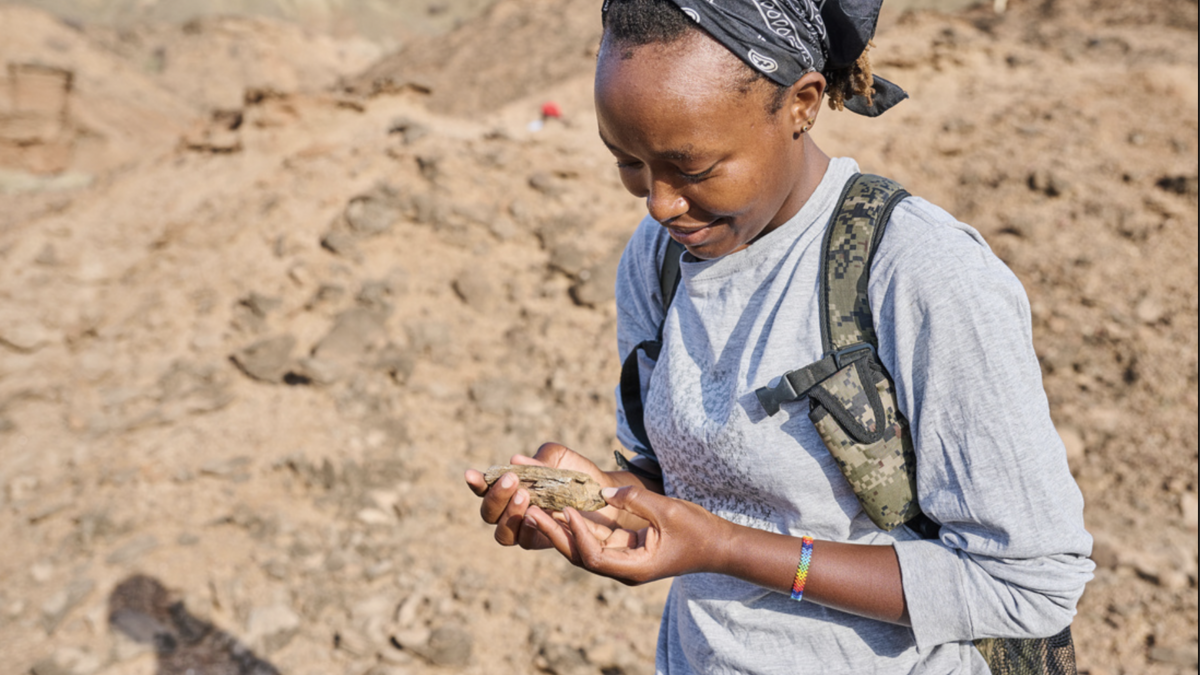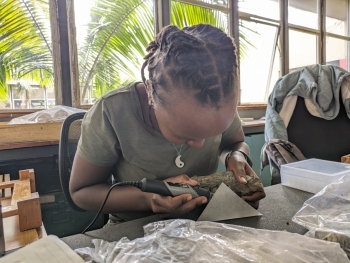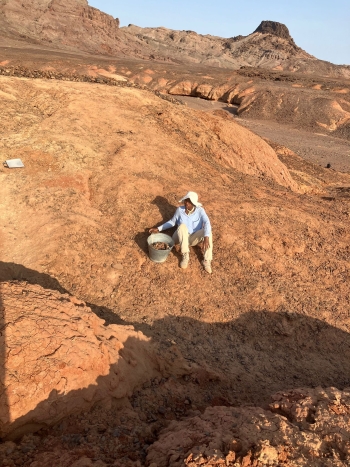Animal tooth enamel gives insight into environment 10M years ago

ASU PhD student Linet Sankau holds a bovid horn core at Lothagam. Courtesy photo
Analyzing the chemical elements from the tooth enamel powder of animal remains can give scientists, like Arizona State University's Linet Sankau, information about the environment of an area millions of years old.
Sankau, a PhD student in the School of Human Evolution and Social Change, is currently conducting research she predicts will give her more insight into climate change that happened millions of years ago in Africa.
“I am currently working on reconstructing the paleoecology of a late Miocene site (around 10 million years ago) in Kenya called Lothagam,” Sankau said. “This is very important because the last common ancestor of humans and chimps probably existed during this time, and also because grasses emerged during this period.
“This research includes reconstructing mammalian diets and looking into the evolutionary pressures that might have existed. As we know, mammals are excellent indicators of what is happening in the environment. With this, we can create a series of events drawing from climatic change, seasonality and vegetation change to tell the evolutionary history of our species.”
ASU News spoke with Sankau about her research.
Note: Answers have been lightly edited for length and clarity.
Question: What brought you to the School of Human Evolution and Social Change?
Answer: I did my undergraduate studies in history and archaeology at Maseno University in Kenya, after which I worked in the paleontology section of the museum in Nairobi for about three years.
I later applied for and completed a master's program in human evolutionary biology at Turkana University College. During my master's (degree), I concentrated on reconstructing the dietary niches and behaviors of fossil bovids (antelope and related species) from the late Miocene period (approximately 10 million years ago) at a site called Lothagam in northwestern Kenya.
Upon completion of my master's degree, I applied for a PhD at the School of Human Evolution and Social Change to further my research. In my doctoral studies, I am extending the focus to investigate the dietary behaviors of all large herbivores collected from the Lothagam site. This broader approach aims to provide a comprehensive understanding of ecological fluctuations during this particular period.
Q: For a layperson, what is your research about?
A: In simple terms, my research revolves around reconstructing ancient environments, a field known as paleoecology. One key method that explains what paleoecology involves will be using stable isotope analysis.
Throughout an animal's life, its diet leaves a lasting imprint in the teeth, even millions of years after death. By extracting enamel powder from these teeth and analyzing isotopic signals, we can deduce the type of diet the animal had.
For instance, using carbon isotopes, which are commonly employed in diet reconstructions, we can determine whether an animal was a grazer, browser or a generalist based on the isotopic values obtained. Also, using oxygen isotopes, we can gauge the amount of precipitation present in an environment.
Additionally, other fossil bones, like limb bones, provide clues about whether the animal was a climber, terrestrial runner or swimmer. Another good example is looking at the relative abundance of species in an environment, because some species are better at telling the type of environment than others. For example, if we have a lot of monkey fossils that we know are climbers, then we will know that the environment must have been a forest or covered with a lot of trees.
Basically, paleoecology allows us to paint a detailed picture of ancient ecosystems and the behaviors of the organisms that inhabited them.
Q: What faculty are helping you with this project?
A: I am working with Chris Campisano and Denise Su, both associate professors at the School of Human Evolution and Social Change, and both of whom are experts in paleoecology and related sciences.
Campisano specializes in reconstructing terrestrial paleoenvironments by combining geological and fossil hominin records. This integration allows for the creation of a temporal-spatial environmental framework, enabling the testing of theories related to hominid and faunal evolution. Campisano leads research in paleontological and geological sites across Africa, Asia and North America.
Su focuses on reconstructing the paleoecology of early hominins to gain insights into the environments inhabited by our early ancestors. Her work aims to understand how environmental factors played a role in shaping hominin evolution. Su also spearheads research in various African sites.
Their combined expertise contributes significantly to the exploration of paleoecological aspects in the context of human evolution.
Q: Why did you decide to focus on this particular research?
A: I became interested in this research because, as humans, we are inherently curious about our origins. Questions like "How did we get here?" and "Why are we so distinct from other organisms around us?" have always intrigued me. My fascination with the history of the world led me to discover that I could actively participate in research that delves not only in the past few hundred years that are recorded in history books, but also in the millions of years defining our planet.
Opting for a focus on the environmental aspect was a natural choice, considering the profound impact that the present-day environment has on the existing flora and fauna. Observing the effects of environments on our evolution today, I recognize the privilege of being able to have a window into how environments might have looked 10 million years ago.
Q: Why is this work important?
A: This research holds significance because, despite offering a relatively narrow glimpse into the past, it sheds light on the selective pressures that our species and other coexisting species experienced. In today's world, where news is filled with information about the rapid warming caused by human-induced pollution, this type of research becomes crucial.
By understanding climatic conditions and species responses from the past, we gain insights into whether similar conditions have occurred previously. This historical perspective can provide valuable lessons that we can leverage to address and mitigate the impacts of contemporary climate change. In essence, it offers a perspective from the past that is instrumental in informing present-day environmental decisions and strategies.
More Local, national and global affairs

ASU Lodestar Center supports Tucson's vibrant nonprofit sector with research, training
If all of the nonprofits in Arizona were grouped together as an industry, they would be the sixth-largest sector in the state in terms of economic impact — ahead of construction, transportation and…

ASU Library collection captures robust history of Arizona
Editor’s note: This is part of a monthly series spotlighting ASU Library’s special collections throughout 2024.Copper, cattle, cotton, citrus and climate.The so-called “five Cs” of Arizona…

ASU helps University of Guyana faculty earn doctoral degrees in expedited program
Shenella Benjamin and Norwell Hinds joined hundreds of other Sun Devils in receiving PhDs from Arizona State University this week, but their journeys were unique.Benjamin and Hinds, both of whom are…

